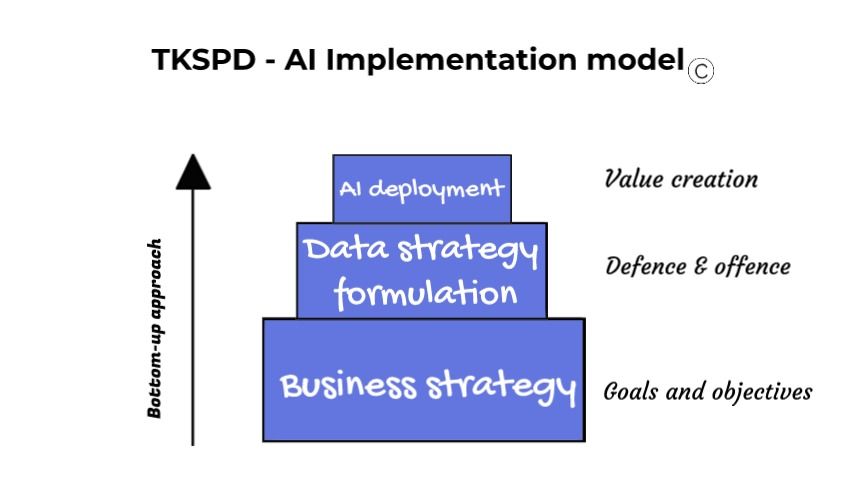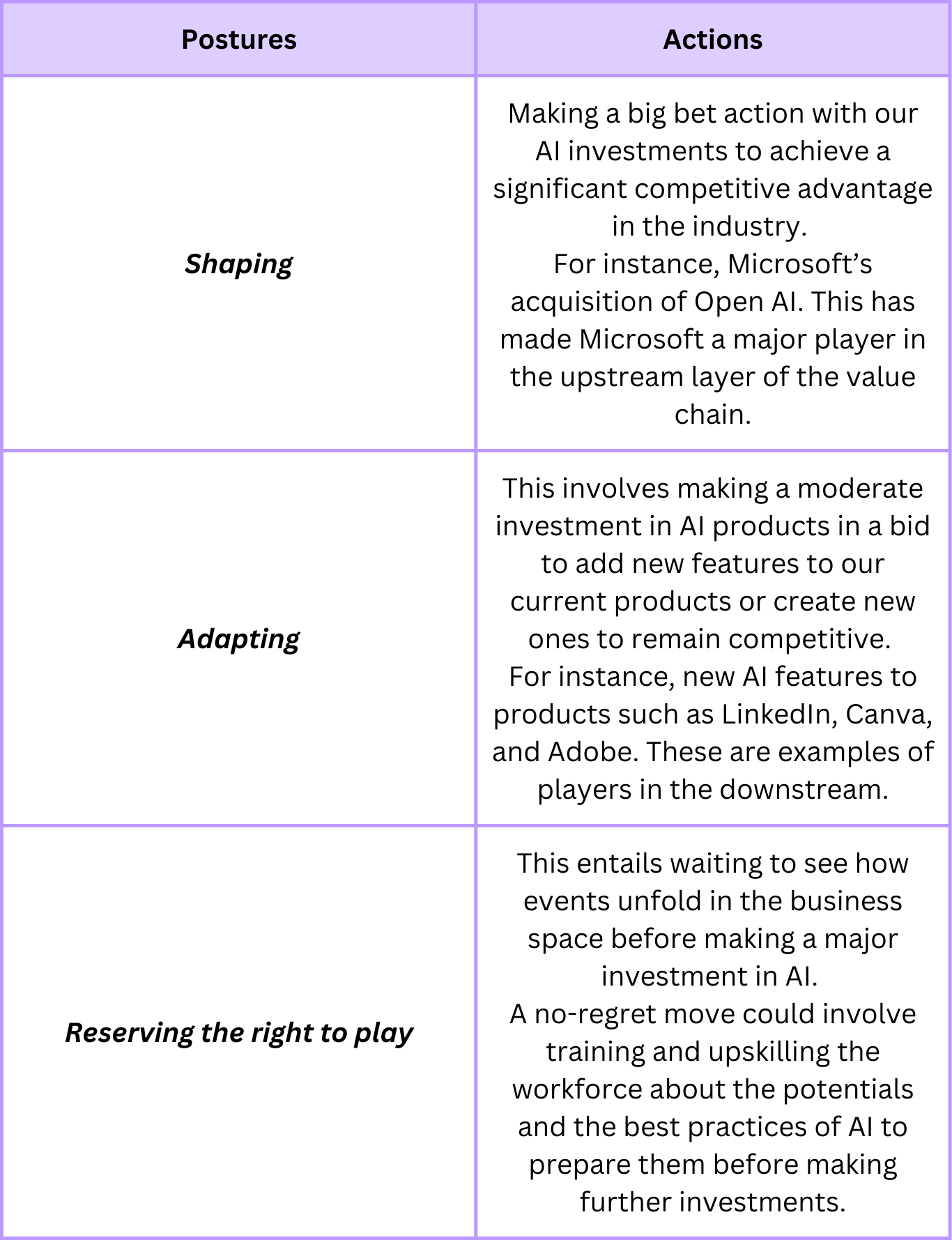The current reality and adoption rate.
The emergence of artificial intelligence (both traditional and generative) has made a significant impact on the way we carry out our business operations.
The traditional AI has been widely adopted across industries, and we have witnessed a significant rise in the operational efficiency and decision-making capabilities of organizations that make use of them.
With generative AI, something remarkable is here. Generative AI uses machine learning and neural networks to learn, understand, and create new contents, such as images, texts, music, and videos. This capability offers a broader number of potential applications and has a potential to revolutionize many industries.
The traditional AI has been widely adopted across industries, and we have witnessed a significant rise in the operational efficiency and decision-making capabilities of organizations that make use of them.
With generative AI, something remarkable is here. Generative AI uses machine learning and neural networks to learn, understand, and create new contents, such as images, texts, music, and videos. This capability offers a broader number of potential applications and has a potential to revolutionize many industries.
The McKinsey global survey on AI in 2024 indicated a significant rise in the number of organizations using AI solutions, with 65% of their respondents reporting a regular use of generative AI (nearly double the percentage from their survey ten months earlier). This trend has led to a sharp rise in AI investments with Goldman Sachs suggesting a $200 Billion global investment by 2025.
However, despite the sharp rise in AI investments, businesses are seen to be struggling to capture business value from their investments.
According to Ganter, 30% of Gen AI projects will be abandoned after proof of concept by the end of 2025. The limiting factors range from poor data quality, inadequate risk controls, and unclear business value.
Consequently, these inadequacies have prompted a systematic approach to ensure a smooth implementation of AI in a profitable manner.
According to Ganter, 30% of Gen AI projects will be abandoned after proof of concept by the end of 2025. The limiting factors range from poor data quality, inadequate risk controls, and unclear business value.
Consequently, these inadequacies have prompted a systematic approach to ensure a smooth implementation of AI in a profitable manner.
A holistic approach to unlocking value from AI.

To ensure that business capture maximum value from data and AI products, certain steps are advised to create an alignment between the business goals, data and AI products.
Using the TKSPD’s AI implementation model we are advised to undertake a bottom-up approach that emphasizes a clear definition of business strategy before designing a data strategy which will eventually become an enabler of AI.
Using the TKSPD’s AI implementation model we are advised to undertake a bottom-up approach that emphasizes a clear definition of business strategy before designing a data strategy which will eventually become an enabler of AI.
The need to understand the business strategy
Every organization is expected to have an ambitious vision. This bold projection of the vision will set a direction for the organization as they compete to survive in the marketplace.
A well-designed business strategy provides a vehicle that allows the business to select the actions that must be taken to ensure the actualization of the vision.
These actions are clearly defined into goals and objectives, and they are expected to be measured so that business stakeholders can ascertain the effectiveness of their chosen strategy.
This is where data comes in.
Ideally, in a cross-functional manner, these goals are expected to be communicated to the data leaders (usually the CDO or CDAO) who then goes ahead to formulate a data strategy that supports the goals and objectives of the business. This is why we advocate that data leaders must strive to develop business acumen and strategic thinking skills.
For data leaders who are time-starved, our 4-hour Business Mastery course is a very good option.
A well-designed business strategy provides a vehicle that allows the business to select the actions that must be taken to ensure the actualization of the vision.
These actions are clearly defined into goals and objectives, and they are expected to be measured so that business stakeholders can ascertain the effectiveness of their chosen strategy.
This is where data comes in.
Ideally, in a cross-functional manner, these goals are expected to be communicated to the data leaders (usually the CDO or CDAO) who then goes ahead to formulate a data strategy that supports the goals and objectives of the business. This is why we advocate that data leaders must strive to develop business acumen and strategic thinking skills.
For data leaders who are time-starved, our 4-hour Business Mastery course is a very good option.
Designing a data strategy
The business strategy of the firm must reflect the data strategy. Consequently, this must be considered before we invest in data infrastructures and must influence the data teams that we ought to build.
Afterwards, we are expected to understand the nature of our industry, including the competitive and regulatory environment before we base our data strategy on the defense/ offense spectrum. The data defense scope covers variables such as data security, quality, governance, including fraud & theft prevention.
Defensive measures provide an effective data management structure to prevent negative outcomes. On the other hand, the offensive side cover data analytics that provide information on variables such as consumer insights and profitability indictors to drive positive outcomes.
Afterwards, we are expected to understand the nature of our industry, including the competitive and regulatory environment before we base our data strategy on the defense/ offense spectrum. The data defense scope covers variables such as data security, quality, governance, including fraud & theft prevention.
Defensive measures provide an effective data management structure to prevent negative outcomes. On the other hand, the offensive side cover data analytics that provide information on variables such as consumer insights and profitability indictors to drive positive outcomes.
AI implementation management
Once we gain an alignment between the business and data strategy, we ought to take data quality issues into consideration before we deploy AI products.
A high-quality data must be complete, consistent, timely, accurate, valid, and full of integrity. To invest in AI products, the following steps are advised.
A high-quality data must be complete, consistent, timely, accurate, valid, and full of integrity. To invest in AI products, the following steps are advised.
1. Opportunity assessment: Work with business stakeholders to ascertain the functions of the business that might benefit from AI. Here we find out the cost and benefits, including the risk factors associated with each opportunity.
2. Ethical and legal considerations: Ensure compliance with regulations, data protection and privacy laws. At this stage, we draw up policies guiding AI practices.
3. Vendor and technology selection: Evaluate AI vendors, platforms, and tools that align with the organization’s objectives and AI policies. Carefully source trustworthy vendors in the upstream space.
4. Change management: Develop a change management plan to address training, cultural shifts and resistance to AI.
5. Performance monitoring and evaluation: Establish KPI’s to measure and monitor the performance including the impact of AI solutions.
If we carefully follow these steps and gain alignment with due diligence, we will increase our chances of deploying AI products successfully and profitably in our organizations.
In addition, our business, data, & AI strategy course provides detailed insights on how data and business leaders can design data and AI initiatives that are aligned with business goals and objectives.
In addition, our business, data, & AI strategy course provides detailed insights on how data and business leaders can design data and AI initiatives that are aligned with business goals and objectives.
Action plan for organizations.
While a few organizations have already started experimenting with AI products, a handful of them are still undecided.
This is because of the volatility, uncertainty, complexity and the ambiguity associated with AI products.
Given these conditions, an action plan that informs organizations of the strategic postures and actions to take is ideal. The table below illustrates the steps according to their magnitude and direction.
This is because of the volatility, uncertainty, complexity and the ambiguity associated with AI products.
Given these conditions, an action plan that informs organizations of the strategic postures and actions to take is ideal. The table below illustrates the steps according to their magnitude and direction.

Ready to take any of these actions?
Write us at:
taiwo@schoolofmba.com
kehinde@schoolofmba.com
Write us at:
taiwo@schoolofmba.com
kehinde@schoolofmba.com



